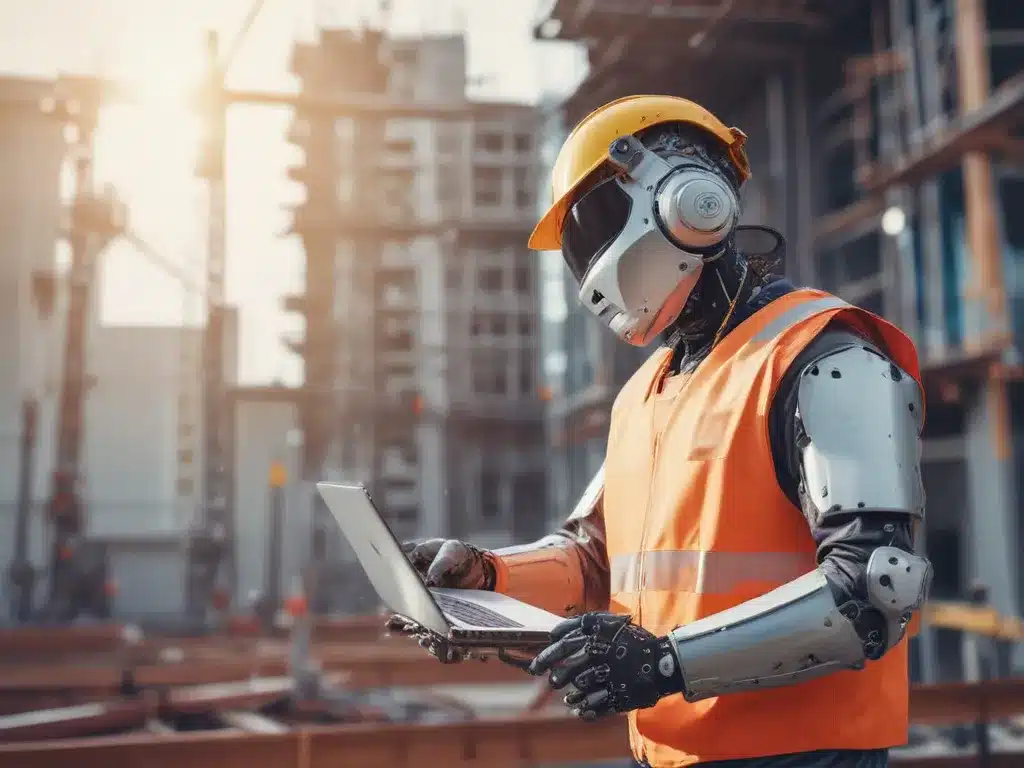
The Rise of Robots in Construction
Robots – once confined to science fiction and industrial assembly lines – are making their way into the construction industry. And let me tell you, these ain’t your grandpappy’s robots! We’re talking about highly advanced machines that can perform tasks with incredible precision, efficiency, and safety.
Imagine a future where construction sites are buzzing with robotic workers, tirelessly toiling away without the need for coffee breaks or union disputes. Okay, maybe that’s taking it a bit too far, but you get the idea. Construction robots are poised to revolutionize the way we build, and it’s an exciting time to be a part of it.
Boosting Productivity with Robotic Efficiency
Let’s face it, construction projects can be massive undertakings, with countless moving parts and tight deadlines. One of the biggest challenges is maintaining productivity while ensuring quality and safety. Enter construction robots, the ultimate multitaskers.
These robotic marvels can work around the clock, tackling repetitive and labor-intensive tasks with unwavering consistency. From bricklaying to welding, robots can perform these jobs with pinpoint accuracy, reducing errors and rework. And let’s not forget about their superhuman strength and endurance – they can lift and maneuver heavy materials with ease, saving time and reducing the risk of injuries.
But wait, there’s more! Construction robots can also be programmed to optimize workflows and streamline processes, eliminating inefficiencies and maximizing productivity. Imagine a world where delays and cost overruns are a thing of the past. Okay, maybe I’m getting a little carried away, but you get the idea. Productivity gains with robots are no joke.
Enhancing Safety on Construction Sites
Construction sites can be dangerous places, with potential hazards lurking around every corner. From falling debris to heavy machinery, the risks are real. But what if I told you that construction robots could help mitigate these dangers and create a safer working environment?
These robotic helpers can take on some of the most hazardous tasks, protecting human workers from harm. Think demolition, working at dizzying heights, or handling toxic materials – robots can handle it all without batting an eye (not that they have eyes, but you know what I mean).
But it’s not just about removing human workers from harm’s way. Construction robots can also be equipped with advanced sensors and safety features, constantly monitoring their surroundings for potential risks. They can detect obstacles, avoid collisions, and even alert human supervisors to potential hazards.
Imagine a construction site where accidents are a rare occurrence, and workers can focus on their tasks without constantly worrying about their safety. Sounds like a dream, right? Well, with construction robots, that dream is quickly becoming a reality.
Overcoming Challenges and Embracing Innovation
Now, I know what you’re thinking: “But robots are expensive, and they’ll take away jobs from hard-working construction workers!” Fair concerns, my friends, but let me address them one by one.
First, the cost of construction robots may seem daunting at first, but in the long run, they can actually save money by increasing efficiency, reducing errors, and minimizing costly delays. Plus, as technology advances and adoption rates increase, the costs are likely to come down. It’s a classic case of short-term pain for long-term gain.
As for job displacement, I won’t sugarcoat it – some roles may indeed be impacted. But here’s the thing: construction robots aren’t meant to replace human workers entirely; they’re designed to complement and assist them. Think of it as a partnership, where robots handle the tedious, repetitive, and dangerous tasks, freeing up human workers to focus on more skilled and creative aspects of the job.
Moreover, the adoption of construction robots will likely create new job opportunities in areas such as robot programming, maintenance, and supervision. It’s all about adapting and embracing the change, my friends.
Real-World Examples and Case Studies
Enough with the theoretical mumbo-jumbo, let’s get into some real-world examples of construction robots in action. Buckle up, because this ride is about to get wild!
Bricklaying Robots
Have you ever watched a bricklayer at work? It’s a mesmerizing dance of precision and skill. But what if I told you that robots can do it even better? Companies like Construction Robotics and Fastbrick Robotics have developed robotic bricklaying systems that can lay thousands of bricks per day with mind-boggling accuracy.
These robots use advanced computer vision and robotic arms to meticulously place each brick, ensuring perfect alignment and consistent mortar application. It’s like watching a well-choreographed ballet, but instead of tutus, you’ve got sturdy bricks and mortar.
But wait, there’s more! These robotic bricklayers can also work in tandem with human workers, allowing for a seamless integration of human creativity and robotic efficiency. Talk about a match made in construction heaven!
Demolition Robots
Demolition can be a dangerous and labor-intensive task, but robots are here to save the day (and maybe a few limbs in the process). Companies like Husqvarna and Boston Dynamics have developed specialized demolition robots that can tackle even the toughest jobs.
These bad boys are equipped with powerful hydraulic arms, sawing and crushing tools, and advanced sensors that allow them to navigate through rubble and identify potential hazards. They can demolish structures with precision and efficiency, reducing the risk of accidents and minimizing collateral damage.
But here’s the real kicker: some of these demolition robots can even climb stairs and navigate through tight spaces, making them perfect for urban demolition projects. It’s like having a team of robotic Spidermen on your construction site, but without the fancy costumes (unless you’re into that sort of thing, no judgment here).
Surveying and Mapping Robots
Before any construction project can begin, you need to have a detailed understanding of the site and its surroundings. Enter surveying and mapping robots, the unsung heroes of the construction world.
These robotic wonders can use advanced sensors and imaging technology to create highly accurate 3D maps and models of the construction site. From topography to underground utilities, they can capture it all with incredible detail.
But that’s not all! Some of these robots can even perform real-time monitoring and analysis, tracking changes in the site conditions and alerting human supervisors to potential issues. It’s like having a robotic guardian angel watching over your construction project, ensuring everything stays on track.
And let’s not forget about the safety aspect. By using robots for surveying and mapping, human workers can avoid exposure to potential hazards like unstable terrain or hazardous materials.
The Future of Construction Robots
As exciting as the current applications of construction robots are, the best is yet to come. Researchers and engineers are constantly pushing the boundaries of what’s possible, exploring new ways to integrate robotics into the construction industry.
Imagine a future where entire buildings are constructed by swarms of autonomous robots, working in perfect harmony to bring architectural visions to life. Or what about self-repairing structures that use robotic systems to detect and fix any issues, eliminating the need for costly maintenance and repairs?
The possibilities are endless, and the future of construction is looking brighter (and more robotic) than ever before. But don’t worry, we’ll always need human ingenuity and creativity to guide these robotic helpers. After all, even the most advanced robots can’t match the sheer awesomeness of a human being (at least not yet).
Embracing the Robotic Revolution
So, there you have it, folks – a comprehensive look at how construction robots can revolutionize productivity and safety in the industry. From bricklaying to demolition, these robotic marvels are poised to change the game.
But don’t just take my word for it; companies like Atchison Construction Inc. are already embracing the robotic revolution, incorporating cutting-edge technologies into their projects and reaping the benefits.
At the end of the day, the choice is yours. You can cling to the old ways and risk falling behind, or you can embrace the future and ride the wave of robotic innovation. Personally, I’m grabbing my surfboard and catching that sweet, sweet robotic swell.
So, what are you waiting for? Join the robotic revolution today and experience the future of construction firsthand. Trust me, it’s going to be one wild ride!





